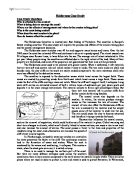SHOULD THE COASTLINE OF EAST ANGLIA BE DEFENDED?
The coastal erosion of East Anglia is increasing rapidly, in places, over 2 metres per year is being lost to the sea. This is caused by both human activities and natural causes.
Firstly, the coast of East Anglia is made up of soft, easily eroded materials such as clay, chalk, sand and silt. The action of the sea naturally erodes this material. Secondly, there is a large body of opinion that feels global warming is adding to the problem. It is felt that because of the activities of mankind, gases are produced, mainly in industry, that damage the ozone layer, which is the layer of gases that protect the earth from the sun. Therefore, the earth’s average temperature has risen, leading to the melting of certain polar regions which adds more water to the earth’s surface and makes the sea rise. The third problem for East Anglia is marine dredging. Offshore dredging removes natural barriers to the sea in the form of rocks, gravel and sand, thereby increasing the pressure of the sea on the coastline.
The town of Clacton is a prime example of this. Neighbouring areas such as Felixstowe and Harwich are dredging and selling vast annual tonnages of gravel and stones. (Ironically, some of this dredged material was recently used in the defence of Walton-On-The Naze’s coastline by being dumped off-shore). By doing this they are depriving Clacton of long shore drift deposits. Clacton’s own beach and coastline is still subject to long shore drift but there is nothing to replace what is washed away from Clacton. Also, Clacton has a narrow beach and a narrow beach is unable to absorb the wave energy it faces. A sandier beach would not only decrease the amount of erosion but would also increase the popularity of Clacton as it relies quite heavily on tourists to its beaches. Tendring Council have considered all options and decided on considerable investment in the area of sea defence and have invested in the installation of ‘Wave-Walker’ energy absorbing block and Rip-Rap boulders in conjunction with repair and improvement to the sea-wall and re-surfacing and drainage improvement on the Promenade. (See the adjoining photographs) Walton-On-The Naze has similar problems and quite regularly loses large chunks of cliff top, its sea defences never having been properly replaced since the floods of 1953 washed most of the old defences away.







